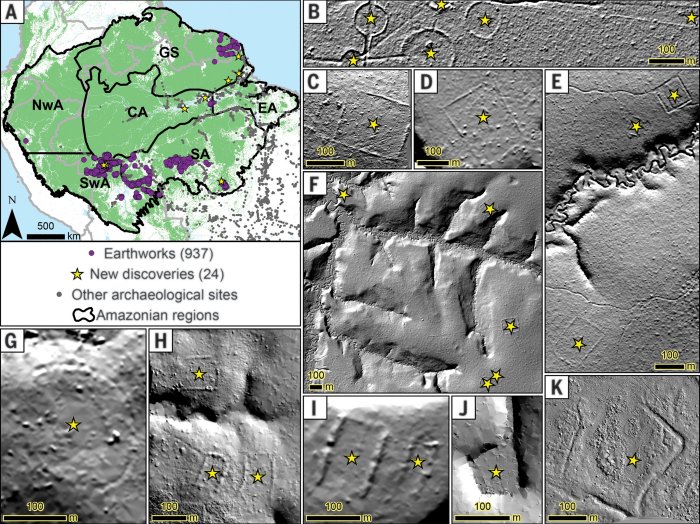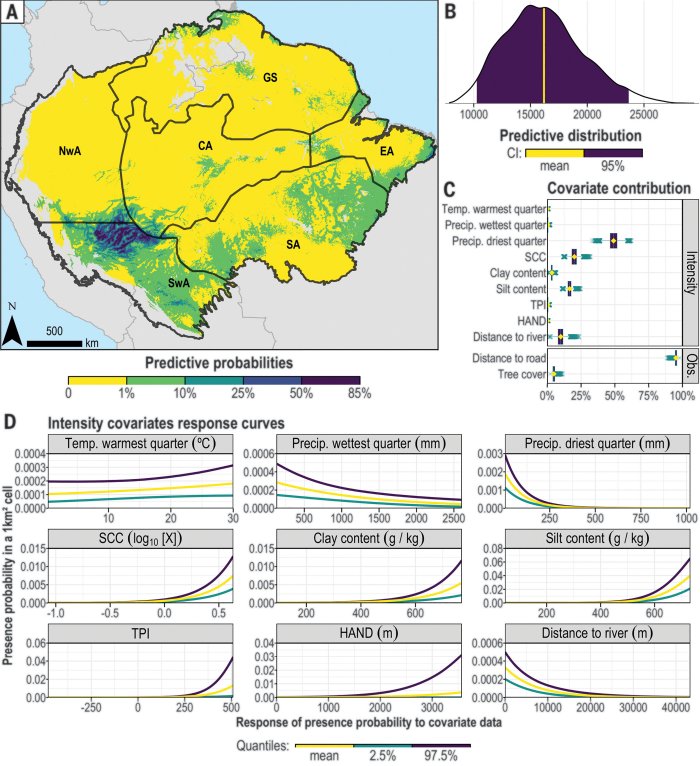Conny Waters – AncientPages.com – More than 10,000 Pre-Columbian archaeological sites likely rest undiscovered throughout the Amazon basin, estimates a new study.

Geographical distribution of known and newly discovered pre-Columbian geometric earthworks in Amazonia. (A) Map of previously reported and newly discovered earthworks (purple circles and yellow stars, respectively) reported in this study across six Amazonian regions: central Amazonia (CA), eastern Amazonia (EA), Guiana Shield (GS), northwestern Amazonia (NwA), southern Amazonia (SA), and southwestern Amazonia (SwA). (B) Newly discovered earthworks in SA. (C to F) Newly discovered earthworks in SwA. (G to I) Newly discovered earthworks in GS. (J and K) Newly discovered earthworks in CA. Scale bars, 100 m. source
The findings, derived from remote sensing data and predictive spatial modeling, address questions about the influence of pre-Columbian societies on the Amazon region.
“The mᴀssive extent of archaeological sites and widespread human-modified forests across Amazonia is critically important for establishing an accurate understanding of interactions between human societies, Amazonian forests, and Earth’s climate,” write the authors.
Indigenous societies have called the Amazon basin home for more than 12,000 years, creating ancient earthwork structures and domesticated landscapes that have had long-lasting effects on modern forest composition.
However, the size and scale of Amazon settlement and landscape transformation are poorly understood – sites are remote and often obscured by dense vegetation. As such, there has never been a comprehensive survey of pre-Columbian sites across the Amazon basin. Airborne LIDAR (light detection and ranging), a remote sensing technique that can map small changes in topography on the ground surface beneath the forest canopy, has been used to discover many previously unknown pre-Columbian structures and earthworks in heavily forested sites throughout Central and South America.
Here, Vinicius Peripato and colleagues searched 5,315 square kilometers of LIDAR survey data and discovered 24 unreported human-made earthworks, including fortified villages, defensive and ceremonial structures, mountaintop settlements, and other geoglyphs, in regions across the Amazon basin.

Probability model of pre-Columbian earthworks across Amazonia.
(A) Predicted probability of earthwork presence for 1-km2 cells across six Amazonian regions using an inhomogeneous Poisson process predictive model: central Amazonia (CA), eastern Amazonia (EA), Guiana Shield (GS), northwestern Amazonia (NwA), southern Amazonia (SA), and southwestern Amazonia (SwA). Areas not modeled (NA) are greyed out. (B) Predictive probability function for the number of as yet undetected earthworks; the dark area under the curve represents the credibility interval (CI) of the probabilities ᴀssociated with each number. (C) Boxplot of the estimated relative contribution of each covariate; the yellow diamond indicates the mean value. SCC, soil cation concentration; TPI, terrain position index; HAND, height above the nearest drainage. (D) Individual predicted probability of earthwork presence against intensity covariates. For projected areas across each Amazonian region on different probability thresholds, see table S2, and for the IPP model on continuous values, see fig. S1.
However, the LIDAR survey data covered only 0.08% of the total area of Amazonia. To better understand where and how many undocumented pre-Columbian sites might occur, Peripato et al. combined the data from their small basin-wide survey, as well as data on other previously identified sites with a predictive spatial distribution model.
According to the model, between 10,272 and 23,648 large-scale pre-Columbian structures remain to be discovered, particularly in southwestern Amazonia.
What’s more, the authors identified relationships between the predicted probability of earthworks and the occurrence and abundance of domesticated tree species and found significant ᴀssociation between the two, suggesting that active pre-Columbian Indigenous forest management practices have long shaped the ecology of modern forests across Amazonia.
“Amazonian forests clearly merit protection not only for their ecological and environmental value but also for their high archaeological, social, and biocultural value, which can teach modern society how to sustainably manage its natural resources,” write Peripato et al.
Paper
Written by Conny Waters – AncientPages.com Staff Writer





